
Background information
An epic quest: finding the best «The Lord of the Rings» game
by Rainer Etzweiler

Despite chaotic development, it got really bad in the end: With Dungeon Keeper, Peter Molyneux and Bullfrog Productions created one of the most unusual strategy games of all time. We look back at the eventful history of the dungeon simulation.
This is an article from our content partner "PC Games". Here you can find the original article by author Olaf Bleich, Benedikt Plass-Flessenkämper and editorial director Lukas Schmid.
Bullfrog Productions was one of the rock stars of the game development scene in the early 90s. Founded in 1987 by Peter Molyneux and Les Edgar, the small team quickly gained a reputation for innovative products. Already the third game of the Brits conquered the mass market: Populous.
The strategy game, released in 1989, founded the genre of "god simulations" and has sold over four million copies to date. It was distributed at the time by Electronic Arts, who recognized the potential behind Bullfrog and their ideas early on. Under pressure from EA, Populous was followed by the strategy game Powermonger (1990) and finally Populous 2: Trials of the Olympian Gods (1991).
Bullfrog grew rapidly in the early 90s and moved to larger offices in the Surrey Research Park in Guildford. Peter Molyneux himself became a video game celebrity, symbolizing the credo behind Bullfrog Productions.
It was he who came up with the first idea for Dungeon Keeper. Funnily enough, the experience gained from the development of the theme park simulation Theme Park (1994) served as the basis. However, Molyneux turned the approach to the setting around: The cheerful amusement park became a gloomy basement vault where the player, as a dungeon master, grew creatures, built structures and fought off invading heroes.
"It was Peter's idea in the first place. It came from a group (on the team) that played a lot of warring board games that developed an amazing dynamic," Dungeon Keeper programmer and Bullfrog contributor Jonty Barnes told Retro Gamer magazine.
The idea was, "What if I, or the player, was an evil person living in a dungeon? And all these do-gooders and knights arrived to destroy what you care about. What if they thought they were doing the right thing when they really had no business being in your realm in the underworld?" said Barnes, elaborating on this point.
And while development of Dungeon Keeper officially began in November 1994, Electronic Arts acquired Bullfrog Productions in January 1995 for an alleged $44 million. This development had a tremendous impact on Bullfrog's direction. For example, the move allowed for massive expansion, with the staff growing from 35 to 60 employees to over 150 in a very short period of time.
Peter Molyneux became vice president of Electronic Arts and on top of that led EA Europe. He was assisted by Les Edgar, who served as Vice President of EA Europe under Molyneux. As a result, Bullfrog Productions lost its creative leadership because Molyneux and Edgar were now rarely on site and instead often at EA headquarters.
With this change in leadership began a nearly three-year developer odyssey that was marked by release delays, contentious personnel decisions and, above all, a lot of crunch.
Lead programmer Simon Carter, artist and producer Mark Healey and designer Barry Meade now took responsibility for the further development of Dungeon Keeper. As a technical basis for the first prototype, they used the graphics engine of the first-person game Magic Carpet from 1994.
In the meantime, the core team continued to work on finishing Dungeon Keeper. Especially the simulation of life inside the dungeon vault presented Bullfrog with major challenges at the time due to limited hardware power.
In addition to the actual game mechanics, the presentation was also crucial to the success of Dungeon Keeper. Mark Healey drew and developed every character in the game and, by his own admission, was the only artist on the team for much of the development period.
Humor played a big part in the gaming experience. And so it was Healey who came up with the idea of having the mouse cursor look like a demon hand. Players could thus not only lift their monsters, but also slap them, so that Imps, for example, worked faster. This melding of the classic user interface and interaction with the scenario itself was unique and added a lot to the atmosphere of the game.
In Peter Molyneux himself at this time grew dissatisfaction with his current position, which prevented him to continue working on Bullfrog projects permanently. "It was crazy - about halfway through development Peter announced that he was leaving Bullfrog and Electronic Arts respectively, but that he still wanted to finish Dungeon Keeper," Mark Healey recalled.
In response, Electronic Arts forbade him to enter the Bullfrog offices. So Molyneux worked out of the home office with Simon and Dean Carter, among other colleagues. The way of working at this point was more reminiscent of young developer studios.
The dungeon heart is the most important part of your dungeon. If it is destroyed, the round is lost. This concept was clear early on in the development of Dungeon Keeper.
Colleagues continued writing the game during the day, trying it out at night, drinking beer and playing pranks on each other. For example, Andy Robson, who was working on Dungeon Keeper as a tester at the time, recalled stealing Peter Molyneux's Tamagotchi in an unguarded moment and sinking it in a cup of tea.
After the game rounds, there were debauched discussions about the game mechanics. If someone won too easily, they changed some parameters the next day and adjusted the game. Jonty Barnes looked back on those days with one laughing eye and one crying eye:
"These processes made up the intensity and strategy of Dungeon Keeper's development. We worked six to seven days a week for a long period of time. But we didn't even notice it because the project was so important to us."
The game took more and more shape over the year 1996 and more and more new information, as well as rumors, spread. The hype around Dungeon Keeper grew. In September 1996, the current product was presented at the ECTS game fair in London. Nevertheless, another postponement of the release date followed - this time from December 1996 to March 1997.
Even though the game was already finished for long stretches, Dungeon Keeper was only really completed in the last few months. Aspects like the soundtrack by Russell Shaw or the characteristic voice-over for the mentor by Richard Ridings were added late in the development.
So far, we have waited in vain for a third part. Dungeons Keeper 3 was in the concept and early development phase after the completion of the second part. Bullfrog announced this in a short post. However, not much more became of the game, as it was discontinued just a month later.
But will there ever be Dungeon Keeper 3? We rate those chances rather low. The strategy genre no longer plays a major role in Electronic Arts' portfolio, and after the disappointing last few attempts, the license seems to be slumbering in the EA archives for the time being. In this sense: Sleep well, Horny ... and maybe see you sometime.
PC games: cutting-edge news, videos, previews and critical reviews, thoroughly researched reports and handy tips on everything to do with PC games, console games and PC hardware.
Interesting facts about products, behind-the-scenes looks at manufacturers and deep-dives on interesting people.
Show all
Background information
by Rainer Etzweiler
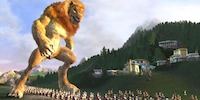
Background information
by Kim Muntinga

Background information
by Kim Muntinga
The 1990s were the decade of great innovations: Thanks to Doom, Duke Nukem 3D and Quake, first-person shooters sprouted like weeds. Command & Conquer and Warcraft, meanwhile, fueled real-time strategy. There was a spirit of optimism among game developers and also the courage to go completely new ways. Bullfrog's dungeon master Dungeon Keeper also appeared during this time. To this day, many fans remember the unusual strategy simulation from the pen of the British studio Bullfrog Productions.
The game design, the bitter humor or simply the option to slap one's own subordinates with the virtual demon hand are just a few points that are still remembered today. But what many people don't know: The development of Dungeon Keeper could hardly have been more chaotic. At times, the game was even completed in the private home of creative head Peter Molyneux. On the occasion of the 25th anniversary of the classic, we take a look back at the curious history of the development of an equally curious game. Off to the dungeon!
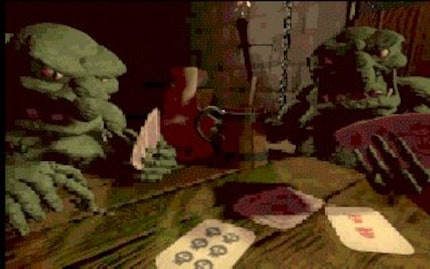
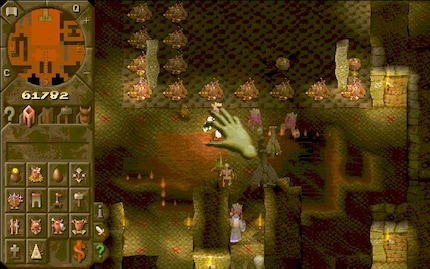
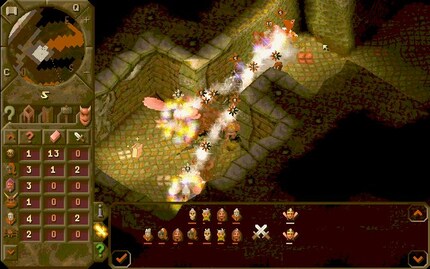
So while the concept for Dungeon Keeper was gaining momentum in early 1994, things were bubbling up behind the scenes at Bullfrog Productions. As early as the end of 1993, there were initial talks with Electronic Arts and other major companies about a possible takeover of the previously independent studio. The negotiations lasted for months.
This early version, however, was quickly discarded and only included the option to move around the map in third-person perspective. Instead, it was Peter Molyneux who once again set the tone, despite all his other official duties. He developed an early 2D prototype from which the action was handled from a bird's eye view. The team eventually ported this approach to the Magic Carpet graphics technology mentioned earlier. Finished was the basis for Dungeon Keeper as it would later be known.
Basically, at this point, the first gameplay cornerstones were already in place, such as building rooms and certain types of facilities like the treasury or the heart of the dungeon. However, the expansion of this concept turned out to be a complex matter, as the structures and their possibilities had to be well coordinated and balanced. The actual level editor was completed in May 1995. In the same month, the dark side of the close relationship with Electronic Arts became apparent.
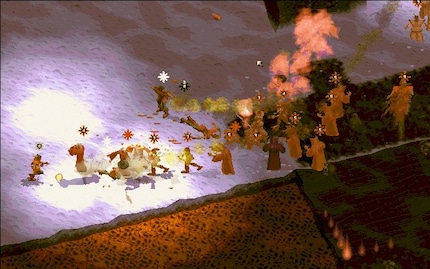
"We were sitting in one of those quarterly meetings and it turned out that another EA studio hadn't finished developing their project. In the corporate landscape, that means a lot of yelling, wailing and gnashing of teeth. So, somewhat naively, we jumped into the breach and said we could finish a game in six weeks - from concept to release," Les Edgar elaborated in the interview. The result was the 3D racer Hi-Octane (1995), which didn't really fit into Bullfrog's portfolio in terms of both quality and direction, but at least it was in stores on time.
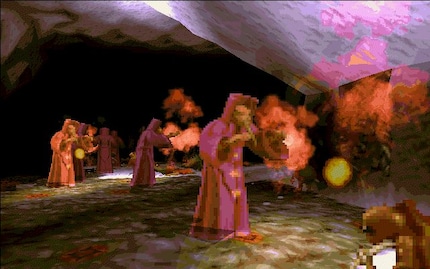
He portrayed units like the Imps, the Fat Devil, and even the affectionately dubbed "Horny" Horned Reaper with a heavy dose of humor, making the characters look gritty but also cute. In the interview, he describes his work wryly: "I can say that keeping a dungeon running is very similar to working at Bullfrog. Once I got into it, the rest was very easy. The Horned Reaper was my design. It was based on one of my ex-girlfriends. She had a similar grin ... And a similar temperament."
The team even experimented with a version that had no options bar at all. Although this gave the graphics more impact, at the same time the controllability of the game suffered. Later, it was decided to use the dialog box placed on the left half of the screen. The behavior of the monsters was also adjusted accordingly, so that they really populated the dungeon and created something like life within the corridors. "The creatures had to be complex, had to be able to fight, and had to be legible in their behavior. But at the same time, their behavior couldn't eat up too much hardware power. So a lot depended on optimization," added Jonty Barnes.
In addition, Dungeon Keeper should also set new standards graphically - for example, with light and shadow effects, some of which were already used in Magic Carpet. In addition, the creators implemented a first-person mode, so that players could slip into the skin of the creatures and sneak through the corridors with them. The amount of ideas seemed endless, but at the same time these possibilities also brought problems. The originally targeted release window of Christmas 1995 could not be kept.
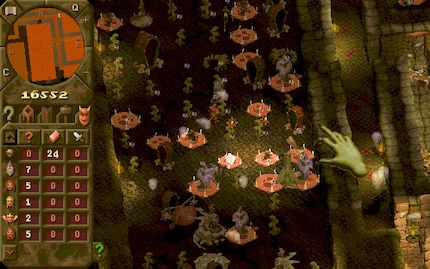
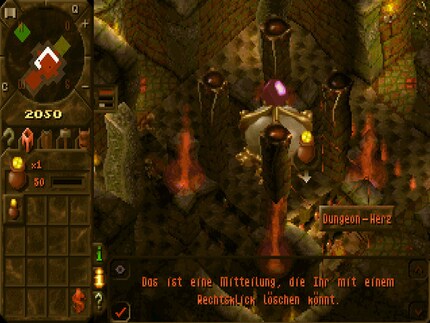
Finally, Dungeon Keeper was released on April 26, 1997. It was the last Bullfrog game under Peter Molyneux, who went on to found Lionhead Studios and devote himself to titles like Black & White and, in later years, the popular Fable trilogy. His departure hit the rest of the team hard. "I felt like the heart of this place was missing. Bullfrog was no longer this creative oasis, it was more reminiscent of a battery of laying hens," Mark Healey soberly summed up.
But this did not diminish the success of Dungeon Keeper. Even though the game did not live up to all the promises made in the run-up, it was still a success. In 1997 alone, EA sold over 100,000 units in the United States. By 2003, it should have sold 700,000 copies. It ranked well behind Theme Park, but was popular enough to find a successor in 1999. Unfortunately, Dungeon Keeper 2 fell short of expectations - perhaps because Peter Molyneux was no longer involved. Reviews and sales disappointed.
The license was dormant until the release of the mobile game Dungeon Keeper in 2014, but the free2play offshoot flopped big time and was heavily criticized for its omnipresent pay options and adapted gameplay. Other titles such as Kalypso's Dungeons series continued the series, at least unofficially.

Priorin Biotin
120 Piece, Capsules, 500 g